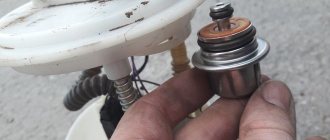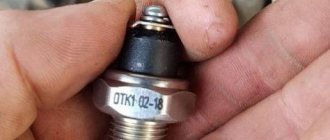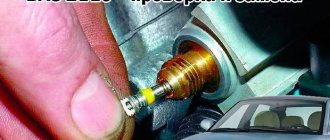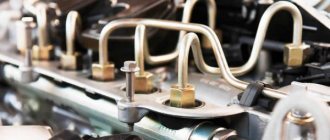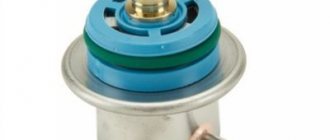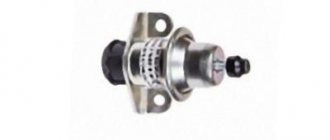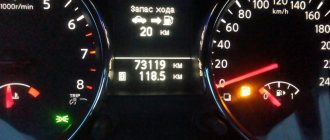Design and operation of RTD
The RTD is a valve with a diaphragm that is installed in the fuel line. When the engine is running, a certain pressure is formed in the system, which must be maintained in the required range, but since the gas pump pumps fuel continuously, the pressure increases. When the pressure increases, the RTD opens the check valve and releases excess pressure into the return system, which communicates with the fuel tank.
Where is it installed?
There are two options for installing an RTD: on the fuel rail and in the fuel tank.
The regulator was installed on the fuel rail on cars with a 1.5 liter injection engine. On such engines, two fuel lines come from the fuel tank: direct and return.
The regulator was installed in the fuel tank on cars with a 1.6 liter engine. In such engines, the return line was abandoned. Now the regulator directly relieves pressure in the car tank.
Preparatory work
- Take a tire pressure gauge and wrap flax or fum tape around the tip, this will prevent fuel spills and air leakage.
- Prepare a hose with a maximum internal diameter of 9 millimeters, and you will also need clamps for fastening. It is necessary to fix the hose on the pressure gauge and tighten everything with clamps.
- Place the prepared tool on the engine so that the hose and pressure gauge fixed on it do not roll off the surface. This will avoid fuel spilling on the engine.
- We unscrew the nipple spool on the ramp (fuel splashing is possible due to residual pressure).
- We put a hose with a pressure gauge on the ramp connections and secure everything with a clamp.
- Homemade pressure gauge for measuring pressure in the rail assembly.
Symptoms of a problem
There are quite a lot of signs of RTD malfunctions and it is quite easy to confuse them with other problems, so before you start replacing, you need to check it, but this is discussed below.
One of the main and most obvious signs of a regulator malfunction is its jamming in the open position. For this reason, engine power drops noticeably. The engine may idle well, but the engine will not be able to develop high speeds due to lack of fuel pressure.
When starting the engine, whether cold or hot, you have to rotate the starter for a long time.
When the RTD is jammed in the closed position, excess pressure occurs, which can cause the fuel pump to fail. Excess pressure in the system leads to increased fuel consumption and incomplete combustion in the combustion chamber. The exhaust gases will have a distinct smell of gasoline with characteristic black smoke.
There are also other less noticeable signs of its malfunction:
- The internal combustion engine operates unevenly at idle and stalls;
- The required internal combustion engine power does not develop;
- The car jerks when driving;
You can learn more about the fuel system in our article.
Diagnostics
There are a number of methods to diagnose the condition. All of them are simple, even a novice car enthusiast can handle them.
- Visually. This is an option for carburetor engines. Pinch the valve or disconnect it. The fault can be determined by how intense the fuel flow is. The method is simple, but inaccurate.
- Pressure gauge. Install the device between the fitting and the hose, temporarily disconnecting the vacuum hose. The reading on the pressure gauge should rise to 0.7 bar.
- By pinching the hose. Check the RTD by clamping the return line. The pressure gauge should respond immediately. If the engine does not rev up, the governor is faulty. Start the engine by clamping the return line. Watch the speed and listen to his work. If its operation is uniform, the adjustment valve is faulty - it must be replaced.
The procedure for checking the performance of an RTD depends on its type - mechanical and electrical components are checked differently.
How to check a mechanical regulator:
- locate the fuel return hose under the hood;
- start the engine - let it run for a minute to warm up a little;
- using pliers - very carefully, pinch the return hose;
- if after clamping the engine begins to work well, then the problem is a broken RTD.
It is forbidden to pinch the hoses for a long time - this creates additional stress on the pump, which leads to its breakdown in the future.
In injection engines, fuel hoses are made of metal rather than rubber to increase reliability. Electrical sensors in such systems are made on the basis of strain gauges. To determine if the RTD on the injector is faulty, check the voltage at the sensor output.
In diesel engines, RTDs are checked by measuring the resistance of the sensor inductor. Usually the normal value is around 8 ohms. If the resistance is noticeably higher, or vice versa, much lower than stated, the regulator is broken. Detailed diagnostics are carried out only in the service center - at special stands where sensors and the entire fuel supply system are checked.
Examination
The check must be carried out using a special device for checking fuel pressure (pressure gauge).
This device is connected to the fuel rail fitting and the engine starts. With a working RTD on 1.5 liter engines, the fuel pressure should be from 2.9 to 3.3 kgf/cm²
Then the vacuum tube is removed from the RTD and measurements are taken again. The fuel pressure should increase by 0.2-0.7 kgf/cm².
Replacement
Replacing the RTD on a VAZ 2110 is not a complicated process when using our instructions. Even an amateur can cope with this task. Before starting work, you need to prepare the tool and vehicle.
Necessary tool
Preparing the car
Before starting work, it is necessary to relieve the fuel pressure in the system. To do this, remove the fuel pump fuse (F15), it is located under the panel on the passenger side. We start the engine and let it run until it stalls.
Next, we remove the negative mark from the battery to avoid fire, since we will be working with flammable substances, such as gasoline.
Step-by-step instruction
- Installation of a new RTD is carried out in the reverse order. Before installing a new regulator, it is recommended to replace the sealing collar and lubricate it with gasoline before installation, so as not to damage it during the process of connecting the RTD to the ramp.
Fuel pressure regulator VAZ 2110 - check and replacement
Fuel pressure is one of the most important indicators used in diagnosing the operation of a car engine. The efficiency and usefulness of all parts that make up the fuel system depend on it. That is why it is necessary to maintain the correct pressure, regardless of the functioning of the engine. This task is precisely performed by the RTD in the VAZ 2110. Every motorist must remember that it is the pressure regulator that affects gasoline consumption and engine power. A faulty regulator will not allow the engine to operate normally and should be replaced.
From this article you will learn what signs of problems with the RTD are most often found in the VAZ 2110, as well as how it is possible to independently check the regulator and replace it.
Tips for motorists
Interruptions in the operation of the engine of the VAZ-2118 Lada Kalina passenger car become very noticeable in idle mode (the engine jerks), as well as when trying to quickly gain speed (the engine does not pull). There are many reasons why an engine may start to work like this. They can be connected both to ignition and power systems, and to gas distribution and crank mechanisms.
It is unlikely that it will be possible to determine immediately what caused the interruptions in engine operation. Therefore, according to the established driving tradition, the search for such a malfunction begins with checking the spark plugs and high-voltage wires. Initially, they check the reliability of the fit of the tips of the high-voltage wires on the spark plugs, and the breakdown of the high-voltage wire to ground is very clearly visible in the dark, naturally with the engine running.
If everything is in order with the high-voltage wires, then you will have to unscrew the spark plugs one by one and check them for the presence of a spark between the central and side electrodes. You need to start this work with a well-warmed-up engine, this will make it easier for you to remove the spark plugs from the cylinder head. Be sure to use a feeler gauge to check and, if necessary, adjust the gap between the electrodes, since an increased gap can lead to misfiring when the engine is running.
Also pay attention to the color of the central electrode insulator, because if there is black carbon on it, the spark plug will not work normally
The engine will operate intermittently in the event of a malfunction in the power system associated with the failure of one of the injectors to inject fuel into the combustion chamber or the pressure in the rail drops below the required level. Considering that the injectors on the Lada Kalina are electromagnetic, and if with the engine running you begin to de-energize their solenoid valve one by one, then by the changed nature of the engine operation you can find a faulty injector. A decrease in pressure in the fuel rail is possible either due to a malfunction of the pressure regulator, or is associated with a malfunction of the fuel pump. But in order to determine this you will need a pressure gauge.
Malfunctions of the gas distribution and crank mechanisms can lead to a drop in compression in one of the engine cylinders. This may be due to leaky valves, as well as breakage or coking of the compression rings.
Due to the fact that the operation of the injection engine is controlled by a controller, and it is located under the interior heater radiator, if it is not sealed, antifreeze begins to drip onto the controller body and if moisture gets inside, malfunctions may occur in its operation, leading to unstable operation engine.
The car became unstable. Although when you start it, it runs normally at high speeds, as soon as it warms up it starts to twitch, not that it shakes, but it’s really noticeable, the steering wheel is already shaking from vibrations. In addition, the engine lost some traction, not much, but noticeably. The check does not light up.
I did the following: - Replaced the spark plugs and Armored wires, also threw in another coil. - Replaced the mass air flow sensor (the old one was dead) - replaced the IAC and TPS and cleaned the throttle (during disassembly I saw a small axial play of the flap, tightened it, I don’t know if it could be from it such an effect?) -Replaced the fuel pump, mesh and filter, as well as the RTD. -I went for diagnostics, there were no errors, the indicators were normal, the mixture in the lambda was a little lean. As a result, I cleaned the lambda. I also tried to drive without a lambda, the check did not light up and there was no difference. — Compression is 13 everywhere (maybe valves? Although the previous owner says that he recently adjusted them) — We also checked the receiver for air leaks — Replaced the DPKV — I looked at the marks on the timing belt It seems to be in place, but there is no mark on the flywheel, I installed it using the old-fashioned method, by unscrewing the spark plug and finding TDC. DPKV hits the 20th tooth. But when the camshaft gear is shifted by 1-2 teeth in both directions, there is practically no difference in the operation of the engine.
The crankshaft pulley also moves a little (+-1 mm), although it has always been like this and it did not affect the operation.
Symptoms of a problem
Before moving directly to the process of replacing the regulator, you need to mention the signs of its malfunction.
The main one is problems in the operation of the valve, especially when the valve does not hold well, i.e. fuel circulates freely. This in turn provokes a decrease in pressure. As a result, the engine power decreases, because it does not have enough fuel to increase speed. When you turn on the engine, it becomes necessary to work for a long time with the starter (i.e., a device that spins the engine shaft in order to start it) in order to create the required pressure. If the valve is completely inoperative, fuel stops being discharged into the tank. This provokes an increase in pressure. As a result, there is excessive consumption of gasoline, as well as incomplete combustion.
In addition, there are other signs indicating a malfunction of the RTD in the VAZ 2110:
- the engine stalls at idle;
- the motor does not work at full power;
- unstable engine operation;
- the content of CO (carbon monoxide) and CH (methane) significantly exceeds the established standards;
- jerking while driving.
How to properly check RTD
In order to independently check the pressure in the system, and therefore the correct operation of the regulator, you need to take a pressure gauge, the maximum pressure in which is up to 10 atmospheres. You should not use a device with a larger scale, as its readings will have a serious error. It connects between the fitting and the fuel pipe:
- first turn off and cool the engine;
- locate the fuel rail under the hood;
- remove the plug from the fuel pressure fitting;
- unscrew the fitting nipple using a spool valve;
- wipe the surfaces if fuel splashes appear under the influence of residual pressure;
- pull a hose with a diameter of up to 9 millimeters onto the fitting and secure it with a clamp;
- Connect the second hole of the hose to the pressure gauge.
Next, you will need an assistant, because the readings from the pressure gauge need to be read at one of four moments:
- when the ignition is turned on, the pressure should be 3 atmospheres;
- at idle speed - 2.5;
- when squeezing the fuel outflow hose - 7;
- with the hose removed on the RTD – 3.3.
How to replace the regulator?
Below you will find step-by-step instructions for replacing the fuel pressure regulator in a VAZ 2110 car. Follow this plan and you will definitely succeed.
- Step 1: Relieve pressure in the fuel line, i.e. in the tubes through which fuel is transferred from the gas tank to the carburetor and back.
- Step 2. Unscrew the nut securing the fuel return pipe (injector hose) to the RTD and remove the pipe.
- Step 3. Remove the two bolts securing the RTD.
- Step 4. Carefully remove the RTD fitting from the ramp hole.
- Step 5: Disconnect the fuel pipe.
- Step 6: Remove the regulator.
- Step 7: Remember to wet the rubber seals with gasoline. If you notice that the rings are inelastic or torn, replace them.
- Step 8. Install a new regulator. To do this, follow these instructions in reverse order.
Any motorist knows that a car cannot go without breakdowns. It is only important to notice their first signs and replace the faulty spare part in time. You should also not panic if there is no car service nearby. Follow the step-by-step instructions and you will succeed. Good luck on the roads!
Source
VAZ fuel pressure regulator: causes of malfunctions and ways to solve them
An important element of the fuel system of any car is the fuel pressure regulator. The performance of the fuel system depends on how stable the fuel pressure regulator is.
The fuel pressure regulator in VAZ cars is a valve-membrane against which the regulator spring rests on the intake manifold side, and the fuel pressure on the other. After stopping the engine, it is the RTD that maintains pressure in the fuel system. If the pressure regulator is worn out, restarting the engine will require some time and manipulation of the ignition key.
The RTD is located either in the fuel tank itself, or, if the fuel system has a recirculation system (increasingly popular), then it moves to the fuel rail. The main task of the RTD is to maintain the difference between the pressure in the tank and the combustion chamber, the injector and the intake manifold. It is thanks to the operation of the fuel pressure regulator that control over the operation of the fuel injectors, the level of pressure in the fuel system is ensured, and excess volumes of fuel are returned to the tank through the return system.
Rail pressure without return
How the fuel system works
Fuel is supplied to the ramp under excess pressure (6 atmospheres), which is created by the fuel pump. Using the pressure regulator on the nozzle, a constant pressure drop of 3 atmospheres is maintained. At constant pressure and a linear characteristic of the injectors, the amount of fuel injected is determined by the duration of the injector control pulse.
How to check?
Let's connect the pressure gauge to the fuel rail. With the fuel pump turned on and the engine not running, the pressure should be 2.8-3.2 atmospheres. If the engine is idling, the pressure should drop to 2.2-2.5 atmospheres. When over-gassing, the pressure gauge needle should deviate into the zone of 2.8-3.2 atmospheres.
Now let's check the operation of the injectors. With the engine not running, we will create the required pressure in the ramp (2.8-3.2 atmospheres), after which, using diagnostic equipment, we will apply a series of test pulses to the first injector, monitoring the change in pressure. The above procedure must be carried out for all injectors. The pressure drop should be the same in all cases. If the results of checking the fuel pressure correspond to those described above, the fuel supply system is working properly.
What will happen if the fuel pressure in the rail is low (less than 2 atm.) or high (more than 4 atm.)? The amount of fuel injected will change in proportion to the pressure deviation from the norm. In other words, the air-fuel mixture will become lean or rich.
It will be especially painful in engine control systems without oxygen sensor feedback, since the controller does not know about the malfunction and continues to calculate the fuel supply for a normal fuel pressure value. In control systems with an oxygen sensor, the controller can compensate for changes in the composition of the air-fuel mixture, but only within reasonable limits.
Troubleshooting
Let us recall the composition of the fuel supply system. It includes: a fuel tank with an installed submersible fuel pump, a fuel filter, fuel lines (supply and drain lines), an injector ramp and a pressure regulator. Any component failure can cause incorrect fuel pressure. Let's try to list common faults for each component.
Gas tank. Through special pipelines, the gas tank communicates with the atmosphere, which prevents its deformation (flattening). If the connection with the atmosphere is broken, a vacuum is created inside the gas tank. In this case, the pressure in the fuel rail may be low.
Gasoline pump. There are several malfunctions:
- the fuel pump does not develop the required pressure, resulting in low fuel pressure;
- the check valve of the fuel pump does not hold pressure, as a result - a rapid drop in pressure after turning off the ignition;
- contamination of the fuel pump mesh filter, as a result - reduced pump performance, which affects the dynamic operating conditions of the engine.
What is a fuel pump? Principle of operation
Fuel lines may be pinched. If this happens to the supply line, then the fuel pressure will be reduced, if it happens to the drain line, it will be increased. In addition, the use of low-quality gasoline with a high tar content can lead to a decrease in the capacity of fuel lines.
Fuel pressure control. There are regulators with a stuck diaphragm in the open or closed position. In the first case, the fuel pressure in the system will be reduced, in the second - increased.
The first sign of RTD malfunction
The first sign of a faulty fuel pressure regulator is increased fuel consumption. The reason for this is simple - due to problems with the RTD, excess gasoline or diesel fuel from the internal combustion chamber does not return to the tank. This leads to an increase in pressure throughout the entire fuel system; Moreover, this increase can be significant - twice or even three times higher than the norm. If the norm is 2 kilograms per square centimeter, then with a faulty RTD this figure can reach 5 and 6 kilograms per square centimeter. This situation cannot take place for a long time, since all the “weak points” of the fuel system are very quickly discovered, and one or another breakdown occurs. In turn, a malfunction in the fuel system is fraught, firstly, with breakdowns, which, in turn, will require major repairs or even a complete replacement of the engine, and, secondly, with serious situations on the road, which are no longer fraught with costs, but with a threat to health and the lives of you and your loved ones.
Failure options
The regulator is a simple device from a technical point of view, so there are few breakdowns that can happen to it. In almost all cases it is recommended to replace the RTD.
- Spring. This is the main failure in the RDT. Due to the weakening of the spring, the engine becomes “starved”, there is not enough fuel at high speeds, when the clutch is pressed and during transient conditions.
- Pollution. When clogged, the ability to pass fuel is lost. The engine stops in any operating mode. If the RTD is heavily contaminated, the pressure in the vehicle rises sharply and fuel leaks through the sealing material. The problem is solved by pumping a large amount of fuel into the fuel pump.
- Jammed. The RTD in the ramp may periodically jam. The car twitches.
Problems and their causes
- Fuel consumption has increased. The cause may be excess pressure in the fuel system due to a faulty fuel pressure regulator.
- The engine power has decreased, the dynamic performance of the car has deteriorated and continues to deteriorate. The reason is often that the RTD has stopped holding pressure (for example, due to a high level of spring wear).
- Problems with starting the engine: in order to start the engine, you have to repeatedly “torment” the starter. The reason is difficulty in the movement of fuel in the fuel system due to a faulty (for example, jammed) fuel pressure regulator.
- The car periodically stalls, and unexpected and unmotivated jerks are possible while driving. The reason is the jamming (permanent or periodic) of the fuel pressure regulator. It is to pressure surges in the network that you owe all of the above “joys”. Such manifestations are extremely dangerous, especially when driving around the city, with a minimum distance between vehicles.
WHAT MAY INDICATE PROBLEMS WITH THE SENSOR
For some reason, the developers did not program into the motor control unit a check function and error messages when this device fails. Therefore, to determine problems with px, only external manifestations in the behavior of the car’s engine are applicable. You can observe the following behavior of the power unit:
- The appearance of floating engine speed;
- Stopping the engine while the vehicle is moving;
- Engine failure when driving in neutral gear.
When diagnosing, it is also necessary to take into account the fact that such “symptoms” of the disease also belong to some other sensors of the power unit.
Also sometimes there are increased idle speeds. This device may also be to blame. High idle speeds can be caused by an “extra” amount of working mixture when the cone needle does not completely fit into its seat. The reasons for this phenomenon may be the formation of carbon deposits or the entry of foreign small particles into the air flow. You can find out what speed the VAZ 2114 should be at idle from the machine’s operating instructions. It is recommended to set the idle speed to 750-800 rpm.
How to check the fuel pressure regulator
If you have any suspicions about the RDT, its performance should be checked as soon as possible. It’s quite easy to do this even at home, just follow a few simple instructions.
We unscrew the fitting responsible for the fuel pressure and inspect the o-ring. Its condition is of great importance, so if this element is old or damaged, you will have to purchase a new ring. The next step is to unscrew the spool valve from the fitting.
At this point you will need a pressure gauge to measure the pressure while the engine is running. And if the pressure is less than what is specified by the manufacturer for the VAZ model you own and the installed engine, the fuel pressure regulator needs to be changed. Moreover, it is inexpensive, the operation itself is very simple, and you can evaluate the result on your first trip.
Source
